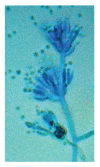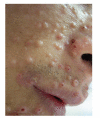Penicillium marneffei Infection in AIDS
- PMID: 21331327
- PMCID: PMC3038620
- DOI: 10.4061/2011/764293
Penicillium marneffei Infection in AIDS
Abstract
Penicillium marneffei is a dimorphic fungus which is endemic in Southeast Asia. It is an opportunistic pathogen which has emerged to become an AIDS-defining illness in the endemic areas. Early diagnosis with prompt initiation of treatment is crucial for its management. Prompt diagnosis can often be established through careful cytological and histological examination of clinical specimens although microbiological culture remains the gold standard for its diagnosis. Standard antifungal treatment for AIDS patients with penicilliosis is well established. Highly active antiretroviral therapy should be started early together with the antifungal treatment. Special attention should be paid to potential drug interaction between antiretroviral and antifungal treatments. Secondary prophylaxis may be discontinued with a low risk of relapse of the infection once the immune dysfunction has improved.
Figures










References
-
- Segretain G. Penicillium marneffei n.sp., agent of a mycosis of the reticuloendothelial system. Mycopathologia et Mycologia Applicata. 1959;11(4):327–353. - PubMed
-
- Capponi M, Segretain G, Sureau P. Penicillosis from Rhizomys sinensis. Bulletin de la Société de Pathologie Exotique et de ses Filiales. 1956;49(3):418–421. - PubMed
-
- Segretain G. Penicillium marneffei n. sp., agent d'une mycose du systeme reticuloendothelial. Mycopathologia et Mycologia Applicata. 1959;11(4):327–353. - PubMed
-
- DiSalvo AF, Fickling AM, Ajello L. Infection caused by Penicillium marneffei: description of first natural infection in man. American Journal of Clinical Pathology. 1973;60(2):259–263. - PubMed
-
- Piehl MR, Kaplan RL, Haber MH. Disseminated penicilliosis in a patient with acquired immunodeficiency syndrome. Archives of Pathology and Laboratory Medicine. 1988;112(12):1262–1264. - PubMed
LinkOut - more resources
Full Text Sources
